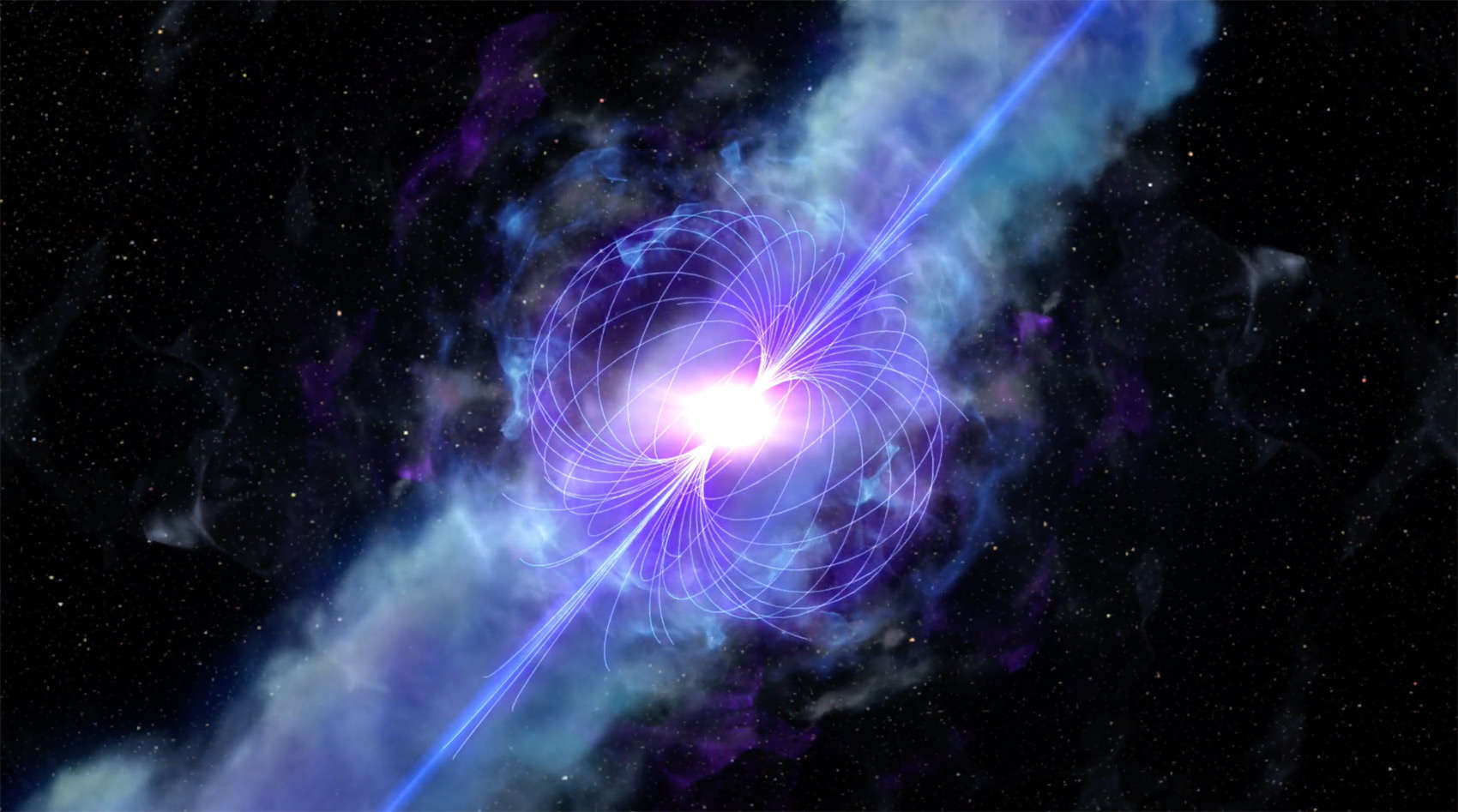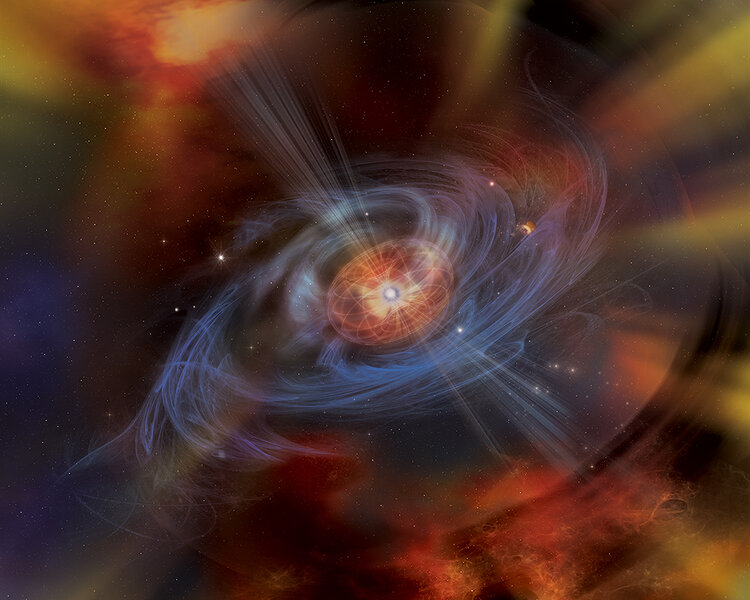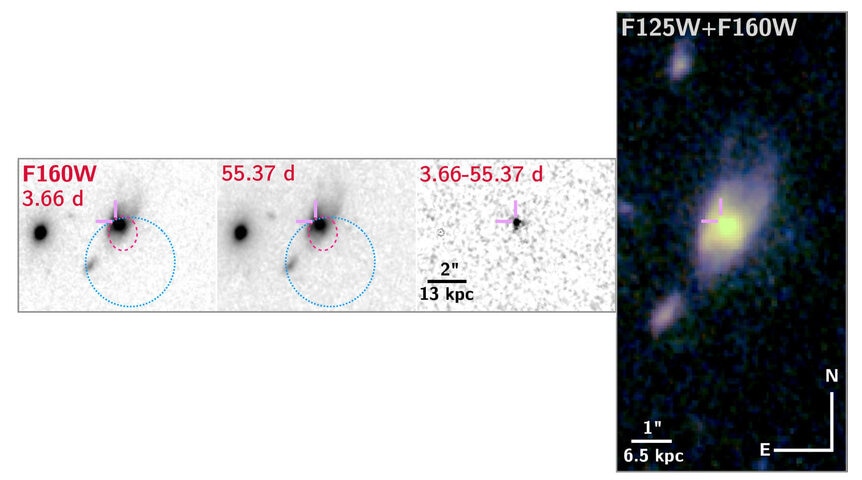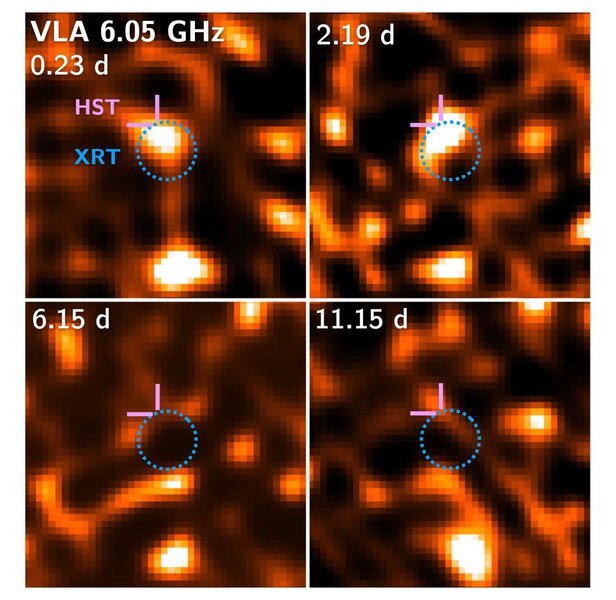Create a free profile to get unlimited access to exclusive videos, sweepstakes, and more!
Did astronomers just witness the explosive birth of a magnetar?

Magnetars are terrifying.
Rapidly spinning neutron stars with gravity a billion times Earth's and magnetic fields a quadrillion times more powerful than Earth's, every single thing about them freaks me the hell out. If you got too close it's hard to know which part of them is scariest: The tides tearing you to pieces, the fierce heat vaporizing you, the magnetic field tearing your atoms apart, or the intense gravity crushing you into a thin paste an atom high.
They can also blast out such powerful bursts of energy that they can physically affect our planet from halfway across the galaxy. That actually happened in 2004, so I'm not kidding when I say it's in our best interest to understand them.
For example: We're not exactly sure how they form. It could be when a massive star explodes, and the core collapses into an über-dense neutron star. Or maybe they're born when two relatively lightweight white dwarfs merge together.
But it's also possible that they're born when two previously formed neutron stars crash into each other. Normally that would create a black hole, but if the two neutron stars are lower mass than usual, they might be able to avoid that fate.
What would that look like?
On 22 May, 2020, the orbiting Swift satellite detected a brilliant flash of gamma rays. Locking on to the pulse, it rapidly observed that spot in the sky with its X-ray, ultraviolet, and optical telescopes. At the same time, it sent an alert to astronomers on Earth below, saying it had found a gamma-ray burst (or GRB) — designated GRB200522A, given the date.
Gamma rays are the highest-energy form of light, and bursts of them can come from a variety of objects. But this one lasted less than a second, so it's what we call a short gamma-ray burst — I know, lame name, but it's descriptive — which is usually when two neutron stars collide.
Swift launched in 2004, and it's seen a lot of these short bursts. But this one got weird.
Follow-up observations found GRB200522A happened in a small galaxy busily churning out stars, and the light took 5.5 billion years to reach Earth. So it's more than a third of the way across the observable Universe! Amazingly, that's about par for the course; most GRBs are seen in distant galaxies. And 70% of all short GRBs occur in galaxies like this one.
It's what came next that was so odd.
When two neutron stars collide, the resulting explosion expels a lot of extremely hot extremely dense material at extremely high speed. Intense magnetic fields focus that material into twin beams, powerful cones of matter and radiation blasting outwards up and down from the collision. This stuff slams into material around the crash, causing it to shine as well.
The matter expelled is so hot it undergoes fusion, creating what are called r-process elements: gold, platinum, strontium, and more. This fusion releases yet more energy, so the material heats up and glows even more. The energy released in this kind of event is more powerful than a nova, but less than a supernova. Since it's roughly a thousand times more than a nova, we call this a kilonova.
Normally, those glow in the infrared. So astronomers pointed the Hubble Space Telescope at GRB200522A, and got a shock: The glow in infrared was easily 10 times what's usually seen from a kilonova. That's very weird.
Also, the X-rays and radio emission faded in an odd way as well, unlike what's usually seen in a short gamma-ray burst. To top it all off, the models showed that to get this GRB to work like a normal one, the jets blasted out would have to be unusually wide cones, wider than have ever been seen in any previous GRBs.
Clearly this was no ordinary event. Too dim for a gamma-ray burst, but the afterglow from GRB200522A was much more powerful than a usual kilonova… as if something were left behind that was adding energy to the material.
A black hole can't do that. But a magnetar can.
And that's what the astronomers think happened here.
So, here's the story they put together:
Long ago, two massive stars orbited each other. Over time one blew up, leaving behind a neutron star, and then the second one did the same. Both neutron stars were likely lightweight for their kind. Over the next few billion years they slowly spiraled together, until, in one cataclysmic event, they collided and merged. A huge explosion ensued, blasting out incredibly dense material, which fused to form r-process elements: the kilonova.
Left behind was not a black hole but instead a magnetar, a massive single neutron star with soul-crushingly strong magnetism. As it spun rapidly its overwhelmingly powerful magnetic field transferred energy to the material around it, causing it to glow much brighter than if a black hole had formed.
5.5 billion years later, in May 2020, astronomers watch in awe as they realize what they've seen.
Magnetars are rare, with only a half dozen or so known in our galaxy. But they're thought to be the engines behind mysterious fast radio bursts (FRBs), brief pulses of intense radio energy that until recently baffled astronomers as to their origin. One was seen coming from a known magnetar in the Milky Way, so they are likely the source of at least some FRBs. And they can also send out superflares, like the one that slammed into us in 2004.
While rare in any one galaxy, there are a lot of galaxies out there, so we see their shenanigans pretty often. If GRB200522A actually was the birth cry of a powerful magnetar, it will be the first one ever seen, and a breakthrough in understanding these astonishing objects.


















